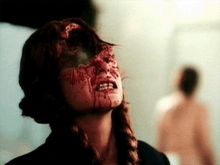The story of a surgeon driven to terrible things by ego, jealousy, and unrequited love, The Crime of Doctor Crespi turns its low budget, limited locations, and relatively simple plot into a dark, dryly funny, and visually compelling little movie with a take on the mad scientist that feels fresher and more modern than many of its '30s contemporaries. Erich von Stroheim deserves much of the credit for his performance in the title role, but director John H. Auer ain't chopped liver.
Dr. Andre Crespi (Stroheim) runs a hospital and is its chief surgeon. He's not an easy man to work for, and his mercurial temper can go from zero to one hundred in an instant, but he gets results. He's brilliant, though he seems to spend roughly 70% of his time in his office leisurely smoking cigarettes (at least fifteen minutes of this movie is Stroheim smoking; if you're a Stroheim fan, you know that's a good thing), experimenting with mysterious liquids in tubes and beakers, gazing at or thumping the skull of the display skeleton of a baby, brooding, taking shots from the liquor bottle in his cabinet, and laughing to himself about a joke we're not in on. He seems weirdly pleased when he reads a newspaper account of a fellow doctor being seriously injured in a car accident.
The injured doctor, Stephen Ross (John Bohn), was a former surgeon at Crespi's hospital, and Crespi served as a mentor to the younger man. Ross married petroleum heiress Estelle (Harriet Russell) and moved on to bigger and better things in the world of medicine. Crespi was also in love with Estelle (though it's hard to imagine him loving anyone) and asked Ross to step aside. Ross clearly refused, so Crespi concocted a years-long revenge plan. This accident is just what he needs to put that plan in motion, and after a performative refusal to save Ross's life when Estelle calls to request him as surgeon, he eventually relents after she begs him in person. Will those strange liquids in the beakers and tubes have anything to do with the plan? Probably not. Just kidding. Spoiler alert: yes.
Things get wild and woolly, and Crespi's dark plot proceeds as planned. The only spanner in the works, as they say across the pond, is Dr. Thomas (Dwight Frye), a young surgeon at Crespi's hospital. Thomas has his suspicions about Crespi, and the recent vicious tongue lashing he received from the old doc for a minor infraction makes him even more determined to take that sucker down. This may be the only performance I've seen from Dwight Frye where he's not going apeshit the entire time. Frye was the go-to actor in '30s horror if the villain needed an insane sidekick or henchman or the town needed a lunatic, but he plays Thomas as the average Joe he is, though he does get to turn on a little of the amped Frye juice in the film's final stretch.
Erich von Stroheim is hilarious as Crespi. He plays him as a man who commits both evil deeds and complicated surgeries with a calm, quiet confidence and a tiny, mischievous spring in his step but who completely loses his shit when any of his employees exhibit even the smallest bit of unprofessional behavior or when a tiny hitch appears in his careful planning. He punctuates his statements and expresses his inner moods with the way he blows out his cigarette smoke, and he has a sadistic little gleam in his eye. Von Stroheim is probably most familiar to contemporary audiences for his role in Sunset Blvd. He was also one of the great directors of the silent and early sound era, and his complex and visually stunning films include Greed, Foolish Wives, The Merry Widow, and Queen Kelly.
Director John H. Auer is not the cinematic stylist or towering artist Stroheim was, but in his own rough and ready way, he packs a visual punch, from the kinetic opening driving scene to the unsettling shots of the hospital corridors to the powerful closeups to the oddball Andy Milligan-esque (years before Andy Milligan) organization of visual space to the weirdly jarring changes in composition from shot to reverse shot. Auer's camera movements are not that graceful, and many of the striking visual moments are preceded or followed by perfunctory ones, but he does a lot of compelling things within the frame. Auer, born in Budapest, was a child actor in Europe who became a businessman after aging out, but he missed the movies and moved to Los Angeles with dreams of becoming a director. After a failed first attempt to land directing gigs in Hollywood, he worked in the Mexican film industry, and the successful movies he made there got him work at Republic back in Hollywood, where he cranked out musicals, crime thrillers, and war movies for the next two decades.
The Crime of Doctor Crespi has been criticized for being a little slow, but I didn't mind its relaxed pace and (until the final third) its relative lack of action. Stroheim is always compellingly watchable, and the supporting actors get nice little character moments or funny bits. Auer is also not afraid to get dark and weird, with oddly lyrical images jumping out between the sillier or more routine moments. I don't think this one's a big crowd-pleaser, but if you like Stroheim, tales of revenge and comeuppance, movies that claim to be adapted from Edgar Allan Poe stories but really aren't (I can't believe how often this happened, from the silent era all the way to the 1990s), and '30s B-movies, give it a whirl.



















